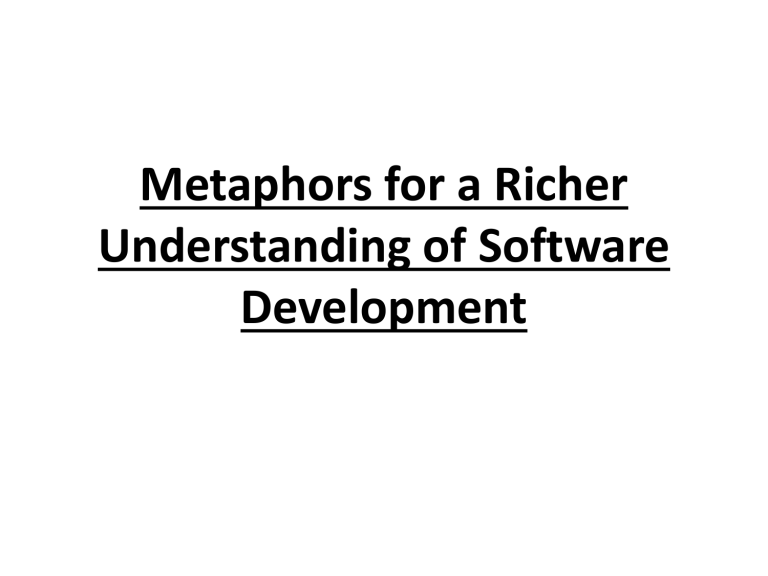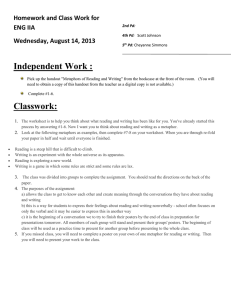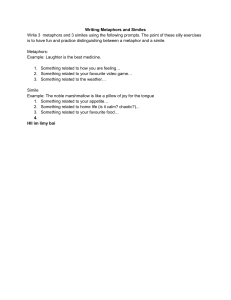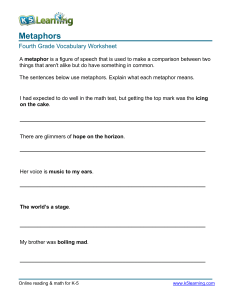
Metaphors for a Richer Understanding of Software Development Contents • • • • • Metaphors Importance of Metaphors Metaphors in Software Development How to use Software Metaphors Some Common Software Metaphors Metaphors • A Metaphor is a figure of speech that makes an implicit, implied, or hidden comparison between two things that are unrelated, but which share some common characteristics. “He is a shining star” Metaphors • Some commonly used metaphors in the field of computer science are viruses, Trojan horses, worms, bugs, bombs, crashes and fatal errors. • These metaphors describe specific software phenomena. • Metaphors help you understand the softwaredevelopment process by relating it to other activities you already know about. Importance of Metaphors • Important developments often arise out of analogies. • By comparing a topic you understand poorly to something similar you understand better, you can come up with insights that result in a better understanding of the less-familiar topic. Importance of Metaphors • The history of science is full of discoveries based on exploiting the power of metaphors. • The chemist Kekulé had a dream in which he saw a snake grasp its tail in its mouth. • When he awoke, he realized that a molecular structure based on a similar ring shape would account for the properties of benzene. • Further experimentation confirmed the hypothesis (Barbour 1966). Importance of Metaphors • The wave theory of light was developed largely by exploring similarities between light and sound. • Light and sound have amplitude (brightness, loudness), frequency (color, pitch), and other properties in common. • The comparison between the wave theories of sound and light was so productive that scientists spent a great deal of effort looking for a medium that would propagate light the way air propagates sound. • They even gave it a name —“ether”—but they never found the medium. • The analogy that had been so fruitful in some ways proved to be misleading in this case. Metaphors in Software Development • Metaphors contribute to a greater understanding of software-development issues in the same way that they contribute to a greater understanding of scientific questions. • But software development is a younger field than most other sciences. It’s not yet mature enough to have a set of standard metaphors. Metaphors in Software Development • A software metaphor is more like a searchlight than a road map. It doesn’t tell you where to find the answer; it tells you how to look for it. • It serves more as a heuristic than it does as an algorithm. • Main difference between the two is the level of indirection from the solution. • An algorithm gives you the instructions directly while heuristic tells you how to discover the instructions for yourself. Metaphors in Software Development • Having directions that told you exactly how to solve your programming problems would certainly make programming easier and the results more predictable. • But programming science isn’t yet that advanced and may never be. • The most challenging part of programming is conceptualizing the problem, and many errors in programming are conceptual errors. • Because each program is conceptually unique, it’s difficult or impossible to create a general set of directions that lead to a solution in every case. How to use Software Metaphor? • How do you use software metaphors? – Use them to provide you the understanding of your programming problems and processes. – Use them to help you think about your programming activities and to help you imagine better ways of doing things. Common Software Metaphors • Some common software metaphors are – Software Penmanship: Writing Code – Software Oyster Farming: System Accretion – Software Construction: Building Software – Applying Software Techniques: The Intellectual Toolbox Software Penmanship: Writing Code • The most primitive metaphor for software development grows out of the expression “writing code.” • The writing metaphor suggests that developing a program is like writing a casual letter—you sit down with pen, ink, and paper and write it from start to finish. • For an individual’s work or for small-scale projects, the letter-writing metaphor works adequately, but it doesn’t describe software development fully or adequately. Software Penmanship: Writing Code • Writing is usually a one-person activity, whereas a software project will most likely involve many people with many different responsibilities. • When you finish writing a letter, you stuff it into an envelope and mail it. You can’t change it anymore, and for all intents and purposes it’s complete. Software isn’t as difficult to change and is hardly ever fully complete. As much as 90 percent of the development effort on a typical software system comes after its initial release Software Penmanship: Writing Code • In writing, a high premium is placed on originality. In software construction, trying to create truly original work is often less effective than focusing on the reuse of design ideas, code, and test cases from previous projects. • In short, the writing metaphor implies a software-development process that’s too simple and rigid. Software Oyster Farming: System Accretion • “Accretion,” means any growth or increase in size by a gradual external addition or inclusion. • Accretion describes the way an oyster makes a pearl, by gradually adding small amounts of calcium carbonate. Software Oyster Farming: System Accretion • Using this metaphor means that you have to learn how to add to your software systems a small amount at a time. • Other words closely related to accretion are “incremental,” “iterative,” “adaptive,” and “evolutionary.” • Incremental designing, building, and testing are some of the most powerful software development concepts available. Software Oyster Farming: System Accretion • In incremental development, you first make the simplest possible version of the system that will run. • It doesn’t have to accept realistic input, it doesn’t have to perform realistic manipulations on data, it doesn’t have to produce realistic output—it just has to be a skeleton strong enough to hold the real system as it’s developed. • It might call dummy classes for each of the basic functions you have identified. Software Oyster Farming: System Accretion • After you’ve formed the skeleton, little by little you lay on the muscle and skin. • You change each of the dummy classes to real classes. • Instead of having your program pretend to accept input, you drop in code that accepts real input. • Instead of having your program pretend to produce output, you drop in code that produces real output. • You add a little bit of code at a time until you have a fully working system. Software Construction: Building Software • The image of “building” software is more useful than that of “writing” software. • It’s compatible with the idea of software accretion and provides more detailed guidance. • Building software implies various stages of planning, preparation, and execution that vary in kind and degree depending on what’s being built. • Example (from book) Software Construction: Building Software • The construction analogy also helps explain why different software projects benefit from different development approaches. • In building, you’d use different levels of planning, design, and quality assurance if you’re building a warehouse or a toolshed than if you’re building a medical center or a nuclear reactor. • You’d use still different approaches for building a school, a skyscraper, or a three-bedroom home. • Likewise, in software you might generally use flexible, lightweight development approaches, but sometimes you’ll need rigid, heavyweight approaches to achieve safety goals and other goals. Applying Software Techniques: The Intellectual Toolbox • Thinking of software-development practices as tools in an intellectual toolbox suggests that every programmer has many tools and that no single tool is right for every job. • Choosing the right tool for each problem is one key to being an effective programmer. Readings • [Chapter 2] Code Complete: A Practical Handbook of Software Construction by Steve McConnell, Microsoft Press; 2nd Edition (July 7, 2004). ISBN-10: 0735619670





